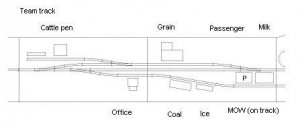A switching puzzle will intentionally have trackage that restricts the number of cars that can be moved at any one time, and will also have some sort of challenge - e.g. least number of moves, fastest time.
A real railroad will not build sidings this way unless it absolutely has to. It does not get any more revenue from a customer whose sidings take 1 hour to switch versus one who takes only 15 minutes. That being said, some "standard" sidings can still take a fair amount of time to switch, especially if more than one industry occupies the same track.
A switching puzzle like The TimeSaver can be done up as a very nice diorama or module type layout. The local chapter of the NMRA has such a layout in a 2x6 form that they take to shows. While it is not yet complete, it can be operated. The challenge is to take cars from an incoming train, drop them to the appropriate industries, and lift the ones that are there, allowing the train to continue. Least number of moves required is usually the measure of success. Timing it just makes people run the switcher at 70 mph


In operation for example, the covered hopper has to be spotted at the grain elevator, the box car at the freight house, and the coal car at the coal dealer. The reefer has to go to the ice house, and the tank car has to be left at the fuel dealer. Click to see the St Lawrence Division
Switching Module (Warning - geocities site with pop-ups and ads!)
The problem with this can be that it becomes quite repetitive, and predictable. It can be mixed up a bit by varying the order of the cars within the arriving train, or leaving more or less cars on the layout to take up space in the sidings. You may add other rules of your own, like the main must be clear after a certain number of moves to allow a passenger train through, or something like that.
Regular operations can also be challenging. I have a small town (Marlpost) with three sidings - one single ended, one double ended (run around) with another single ended siding off that. (See below).
It takes about 15 to 25 minutes to switch a 4-5 car train. I have also instituted rules that were in force on CN in the 1920s and 30s, such as stock cars must be blocked immediately behind the engine for ease of handling at the end of the job (cattle had to be fed and watered on a regular basis while in transit). And any cars at the grain elevator must be returned to their original spot if moved. This adds to the complexity and realism of operations in Marlpost.
Hope that helps.
Andrew


